Florence Griswold suffered reversals of fortune that, in the end, transformed her beautiful old Georgian home into the Old Lyme Art Colony, the most famous collection of artists in its day. In the process, she gave Old Lyme, Conn., a new identity and shaped the careers of a generation of artists.
Florence Griswold
Florence Griswold was born Dec. 25, 1850 in Old Lyme, Conn., the youngest of four children. Her family was descended from early settlers of the town, and her father was a prosperous sea captain. In 1841 he bought a Georgian mansion on a 12-acre estate for his new bride.
Two decades later, the arrival of the Civil War and steam-powered vessels forced Florence’s father into early retirement. Bad investments cost him his fortune.
Old Lyme, once a prosperous shipbuilding town, fell on hard times as well.
So to make ends meet, Florence’s mother and two sisters in 1878 turned the rambling house into a school for girls. Then Florence and her sister Adele found themselves in a financial bind when their father, mother and sister died.
In 1892 the sisters started to take in boarders, an acceptable way for women to make money and a fortunate choice for Florence and the American art world.
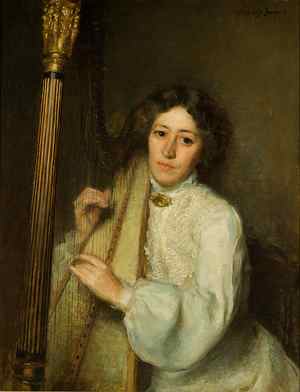
Florence Griswold. Painting titled The Harpist by Alphonse Jongers, 1903. Courtesy Florence Griswold Museum.
The Old Lyme Art Colony
In 1899, artist Henry Ward Ranger came to Old Lyme, having just returned from the European art scene. He saw in the pretty coastal town an American version of France’s Barbizon, which spawned its own school of art.
Ranger rented a room from Miss Florence and encouraged his friends to come to Old Lyme. The next year, his friends Lewis Cohen, Henry Rankin Poore, Louis Paul Dessar, and William Henry Howe joined him. Two hundred more artists would pass through the colony over the next three decades, creating a school of art known as American Impressionism.
Florence Griswold called herself ‘the keeper of the art colony.” The artists called her Miss Florence. She charged $7 a week for a room, which included meals, a daily pitcher of water and a kerosene lamp to find one’s way to one’s rooms (or around the rooms) at night. She made sure the artists returned year after year by writing them during the winter.
Miss Florence also took a strong interest in the artists’ work and forever tried to sell their paintings. She turned the front hall into a gallery, where she sold the artists’ framed paintings and old furniture.
In August 1902, 12 of the artists put on an exhibition in the Old Lyme Public Library. The Hartford Courant reported the library was ‘thronged’ by visitors from Hartford, New Haven, Middletown, New York, New London, Boston, Chicago, Springfield and elsewhere.
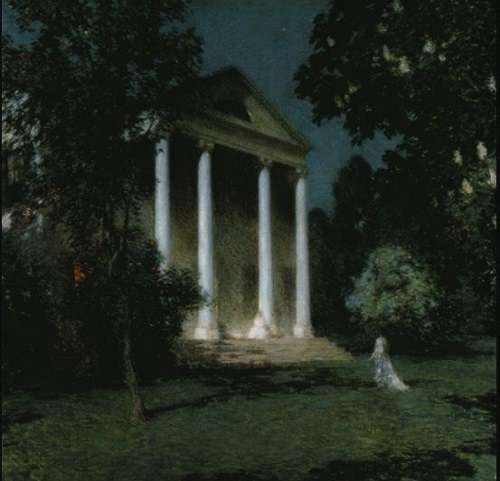
Detail from May Night (1906) by Willard Metcalf, National Gallery of Art, Washington, D.C. The painting depicts the Griswold house.
Childe Hassam Arrives
The success of the exhibit may have attracted Childe Hassam the next year. Hassam, a prolific and influential artist, then in his 40s, had a lot of friends. As the popularity of the summer exhibitions grew, some of the country’s best artists began making the pilgrimage to Old Lyme.
The artists turned barns and sheds into studios. They painted the First Congregational Church, the bridge nearby and old fruit orchards. Mountain laurel, which grew especially well in Old Lyme, was a favorite subject for many of the artists. One artists stuck cotton balls to laurel shrubs so he could paint them after their blossoms faded.
Miss Florence created a warm, cheerful atmosphere. She also provided a respectable veneer for the bohemian habits of the artists. Childe Hassam, in a July 3, 1905 letter, called the Griswold house ‘just the place for high thinking and low living.’ Archaeologists later discovered a stash of beer, wine and liquor bottles in the crawl space under Hassam’s studio.
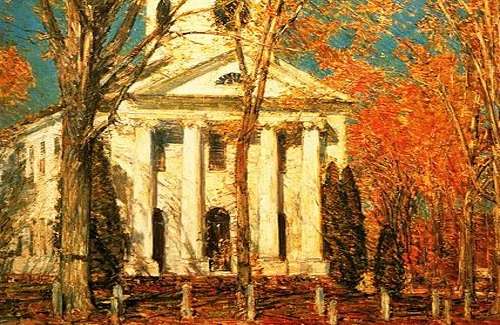
Detail from “Church at Old Lyme,” oil on canvas, by Childe Hassam. Courtesy of the Albright-Knox Art Gallery.
No Inconsiderable Chapter
Caroline Weir Ely, daughter of artist J. Alden Weir, knew the Old Lyme Art Colony well.
“Miss Florence was the life of the house,” she wrote, “happy go lucky, always ready to get up a picnic, arbitrator of quarrels, and the first to lead the way to the abundant larder, which, night after night, was raided of its new cakes and pies.”
Miss Florence died in 1937. In her obituary, the New York Times wrote, “This generous spirit survives; and not in the Griswold House alone, but as part of no inconsiderable chapter in the history of our native art.”
Her legacy lives on in the renowned Florence Griswold Museum, the ‘Home of American Impressionism.’ You can visit the museum campus year round (click here for more information).
This story about the Old Lyme Art Colony was updated in 2022.
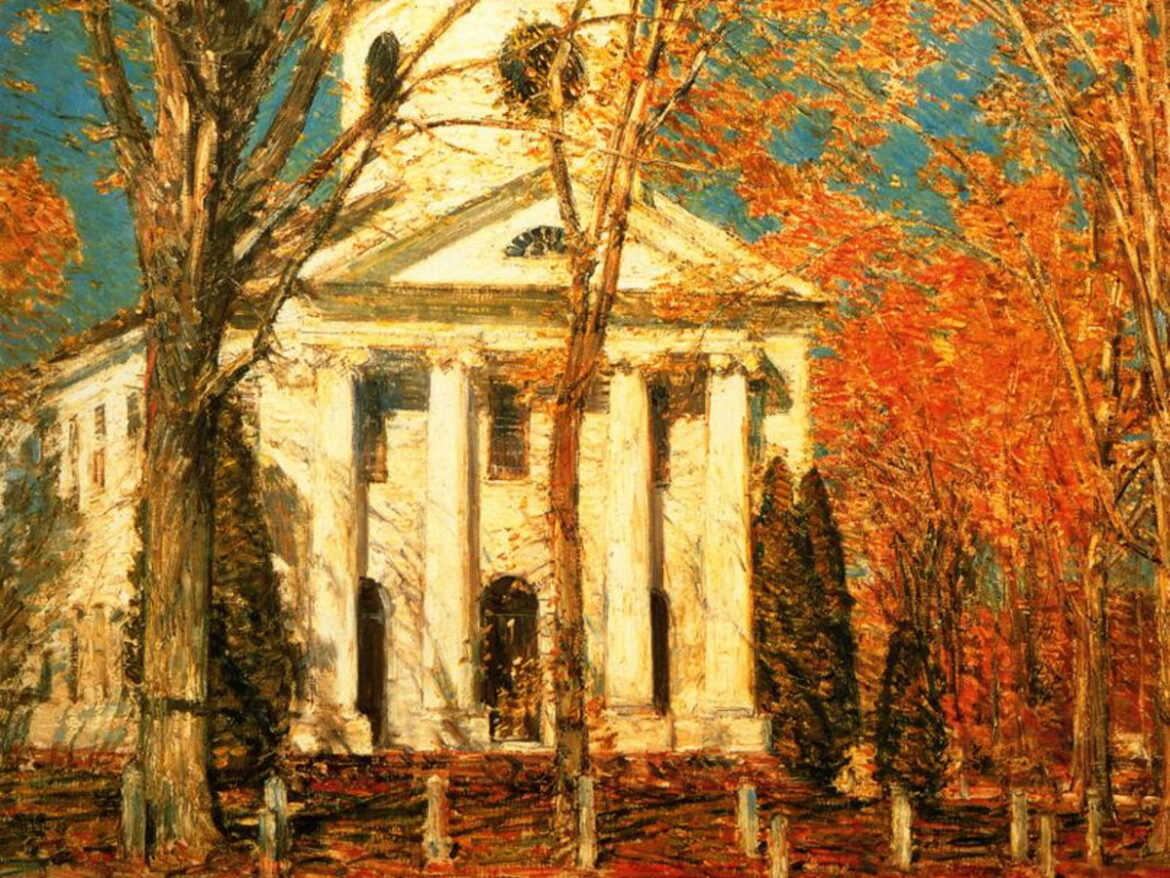
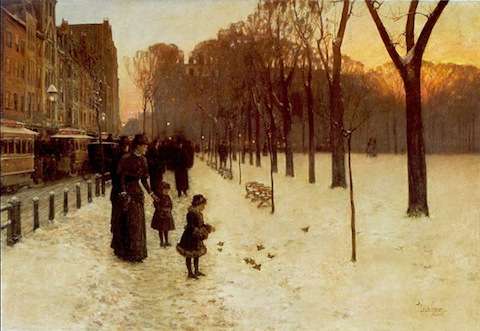
15 comments
Vanessa y Mario: yo quiero ir a este museo
¿Dónde y cuándo?
¿el fin de semana del 11 de enero?
MASS?
Merry Christmas
Ivys, sounds like a plan to me! Let’s. And Merry Christmas!!
yay Vanessa!
[…] an extraordinary honor before she reached the age of 40: She was allowed to paint on a door in Miss Florence Griswold’s house in Old Lyme, […]
[…] even after the naval fleet stopped visiting in the 1930s, wrote Bartlett. It continued to attract plein air painters, and the artist John Buckley bought the shack in the 1930s to use as his […]
[…] rested his in New England, spending several summers in Watch Hill, R.I. and at least one in Old Lyme, […]
[…] of Greenwich. By 1890, the artistic community that gathered at the Bush-Holley House included Childe Hassam, Ernest Lawson and Theodore Robinson. There they tried new painting techniques and […]
[…] its doors in 1776. It was founded by three brothers, who were not Griswolds, but named it after the Griswold family in the area. Only six families have ever run it. The British captured The Gris during the War of […]
[…] the largest and most important in the United States for 20 years from about 1900. It started when Florence Griswold and her sister Adele fell on hard times, as had New London. The Griswold sisters began to rent […]
[…] years earlier, 16 ladies, including art colony founder Florence Griswold, formed Old Lyme's group of antis. Within a year the antis filled Town Hall for a speaker who […]
[…] in the mid-1890s, Hassam painted in Gloucester, Mass., Provincetown, Cos Cob and at the Old Lyme Art Colony in […]
Comments are closed.